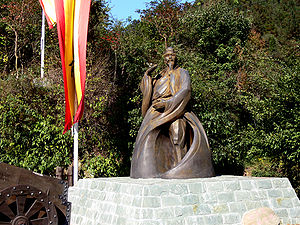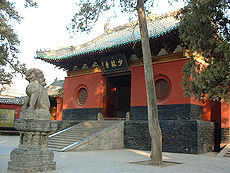- Zhang Sanfeng
-
Part of the series on
Chinese martial artsList of Chinese martial arts Terms Historical places - Shaolin Monastery (少林寺)
- Wudang Mountains (武當山)
- Mount Hua (華山)
- Mount Emei (峨嵋山)
- Kunlun Mountains (崑崙山)
Historical people - Five Elders (五祖)
- Yim Wing-chun / Yan Yongchun (嚴詠春)
- Hung Hei-gun / Hong Xiguan (洪熙官)
- Fong Sai-yuk / Fang Shiyu (方世玉)
- Dong Haichuan (董海川)
- Yang Lu-ch'an (楊露禪)
- Wu Quanyou (吳全佑)
- Ten Tigers of Canton (廣東十虎)
- Chen Fake (陳發科)
- Chan Heung / Chen Xiang (陳享)
- Wong Fei-hung / Huang Feihong (黃飛鴻)
- Sun Lu-t'ang (孫祿堂)
- Huo Yuanjia (霍元甲)
- Yip Man / Ye Wen (葉問)
- Wang Zi-Ping (王子平)
- Bruce Lee / Li Xiaolong (李小龍)
- Jackie Chan / Cheng Long (成龍)
- Sammo Hung / Hong Jinbao (洪金寶)
- Yuen Biao / Yuán Biāo (元彪)
- Jet Li / Li Lian Jie (李連杰)
- Donnie Yen / Zhēn Zǐdān (甄子丹)
Legendary figures - Bodhidharma / Putidamo / Damo (菩提達摩)
- Zhang Sanfeng (張三丰)
- Eight immortals (八仙)
Related Zhang Sanfeng (simplified Chinese: 张三丰; traditional Chinese: 張三丰; pinyin: Zhāng Sānfēng; Wade–Giles: Chang1 San1-feng1) was a semi-legendary Chinese Taoist priest who is believed by some to have achieved immortality, said variously to date from either the late Song Dynasty, Yuan Dynasty or Ming Dynasty. His name is said to have been Zhang Junbao 張君寶 before he became a Taoist.
Zhang's legend is that of indifference to fame and wealth. After declining official position and dispatching his property to his clan, he traveled around China to live the life of an ascetic. Zhang spent several years at Hua Mountain before settling in Wu Tang Mountain.[1]
Contents
Legacy
A legendary culture hero, Zhang Sanfeng is credited by modern practitioners as having originated the concepts of neijia (內家); soft, internal martial arts, specifically T'ai Chi Ch'uan, as a result of a Neo-Confucian syncretism of Chán Buddhist Shaolin martial arts with his mastery of Taoist Tao Yin (neigong) principles. It is said that on one occasion Zhang Sanfeng observed a bird attacking a snake on Wudang Mountain and was greatly inspired by the snake's defensive tactics. It remained still and alert in face of the birds onslaught until it made a lunge and fatally bit its attacker. This battle inspired him to create a 72-movement T'ai Chi Ch'uan“set.”[2] He is also associated in legend with the Taoist monasteries at Wudang Mountains in Hubei province.
Huang Zongxi's Epitaph for Wang Zhengnan (1669) gives him credit for the development of a Taoist "internal martial arts" style, as opposed to the "external" style of the Buddhist martial arts tradition of Shaolin. Stanley Henning's article, "Ignorance, Legend and Taijiquan" is critical of the myth that Zhang San Feng created Tai Chi Chuan, and asserts that it is very likely that Zhang never existed.[3]
Zhang Sanfeng is also said to have been versed in Shaolin Gung Fu, an expert in the White Crane and Snake styles of Chinese martial arts, as well as in the use of the Chinese straight sword or jian.[citation needed] According to relatively late (19th century) documents preserved within the Yang and Wu family's archives,[citation needed] the name of Zhang Sanfeng's master was Xu Xuanping (許宣平), said to be a Tang dynasty hermit poet and Taoist Tao Yin expert.
The Tai Chi Chuan families who ascribe the foundation of their art to Zhang traditionally celebrate his birthdate as the 9th day of the 3rd Chinese lunar month.
Traditional folktales
Much of the written material about him is mythical, contradictory, or otherwise suspect. For instance, he is reported by different people to have been born either in 960, 1247, or in 1279. He has at times been described as being seven-feet tall, with the bones of a crane and the posture of a pine tree, having whiskers shaped like a spear, and being able to cover 1000 li in a day (roughly 580 km or 350 miles). He is reputed to have worn a straw hat, and is usually depicted with one slung on his back, but two villages are reported in the 19th century Wu-yang Gazeteer (Wu-yang hsien-chih) to have believed that his hat was actually a cymbal, which only residents of the villages (famous for manufacturing cymbals) had permission to sound upon meeting him.
Some sources record two Chinese emperors sending missions to Zhang Sanfeng to ask for his advice, although neither mission is reported to have found him.
Owing to his legendary status, his name frequently appears in Chinese novels and Wuxia films of swordsmen as a spiritual teacher and master of martial arts. One of the films is Tai Chi Master starring Jet Li and portrayed by him.
Today, Chinese readers and general public are most acquainted with Jin Yong's version of Zhang Sanfeng, thanks to the popularity of his Wuxia novels. Zhang's popularity also attributes to his personal characters. He has a personality mixed with Confucianism and Taoism that make him very endearing to most of the Chinese people.[4]In Jin Yong'z book The Heavenly Sword and Dragon Saber, Zhang Sanfeng was a former Shaolin disciple in the late Song Dynasty, and born on April 9, 1247 at midnight (Day 9 of month 3 in Chinese calendar). He later left Shaolin Temple and established the Taoist monasteries in Wudang Mountains. In the book he had seven disciples, and was alive at least until the late Yuan Dynasty. According to many regional gazettes, Zhang Sanfeng was seen at the end year of Tianshun reign (1457–1464), having lived for more than 200 years.
Lineage tree
This lineage tree is not comprehensive.
Legendary Figures
Zhang Sanfeng*
c. 12th century
NEIJIAWang Zongyue*
T'AI CHI CH'UANNote: These are legendary or semi-legendary figures in the lineage, which means their involvement in the lineage, while accepted by most of the major schools, isn't independently verifiable from known historical records.
Five major classical family styles
Chen Wangting
1580–1660
9th generation Chen
CHEN STYLEChen Changxing
1771–1853
14th generation Chen
Chen Old FrameChen Youben
c. 1800s
14th generation Chen
Chen New FrameYang Lu-ch'an
1799–1872
YANG STYLEChen Qingping
1795–1868
Chen Small Frame, Zhaobao FrameYang Pan-hou
1837–1892
Yang Small FrameYang Chien-hou
1839–1917Wu Yu-hsiang
1812–1880
WU/HAO STYLEWu Ch'uan-yu
1834–1902Yang Shao-hou
1862–1930
Yang Small FrameYang Chengfu
1883–1936
Yang Big FrameLi I-yu
1832–1892Wu Chien-ch'uan
1870–1942
WU STYLE
108 FormYang Shou-chung
1910–85Hao Wei-chen
1849–1920Wu Kung-i
1900–1970Sun Lu-t'ang
1861–1932
SUN STYLEWu Ta-k'uei
1923–1972Sun Xingyi
1891–1929References
- ^ Albert Liu, Nei Jia Quan: Internal Martial Arts, North Atlantic Books, 2004
- ^ Mount Wudang -- Abode of Immortals and a Martial Monk, by staff reporter HUO JIANYING (front page)
- ^ Henning, Stanley (Autumn/Winter 1994). "Ignorance, Legend and Taijiquan" (PDF). Journal of the Chenstyle Taijiquan Research Association of Hawaii 2 (3): 1–7. http://seinenkai.com/articles/henning/il&t.pdf.
- ^ Zhang Sanfeng
- Wile, Douglas Lost T'ai-chi Classics from the late Ch'ing Dynasty (1996) State University of New York Press, Albany. ISBN 0-7914-2653-X
- Albert Liu, Nei Jia Quan: Internal Martial Arts, North Atlantic Books, 2004
- Journal of Asian Martial Arts Volume 16, No. 4, 2007. Via Media Publishing, Santa Fe, New Mexico USA. ISSN 1057-8358
External links
- Master Chang San-Feng by Michael P. Garofalo
Categories:- Chinese Taoists
Wikimedia Foundation. 2010.


